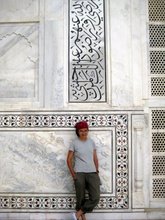May 4th, 2008
Hello, family and friends,
Ethnography is "a genre of writing that uses fieldwork to provide a descriptive study of human societies". Many ethnographic studies require the researcher to be fully immersed in the target community for an extended period of time—at least two years—to observe the community. Essentially s/he becomes part of the community, participating in the rituals and daily life of the people. Within these two or more years, it is easy to form close relationships with the locals. During our time in the Kumaon, we are reminded that we should carry the mindset of an ethnographer. However, we are also reminded that within our short three month stay, it is unlikely that we will form any close relationships with the locals. I can already say that this is not true with me. Once I leave, I will definitely miss the relationships that I have forged here.
There are certain qualities that a talented doctor would possess. And Dr. Asha Uphadyay possesses all these qualities and more. I owe her part of my life, because she cured my painful GI infection. After leaving the clinic that day with a feeble thank you, I didn't think that I would ever visit the doctor as a friend. While being so wrapped in my suffering, I didn't think twice about the incisive yet compassionate way she questioned the three ill students who went to see her. When I began to regain my strength, I started to wonder how she was able to quickly and accurately diagnose one of the students with hepatitis A, when he was only displaying pre-jaundice symptoms. The natural cynic within me bluntly reasoned that with the high incidence of hepatitis A in rural India, it must've been a simple diagnosis. However, a part of me still remained very impressed.
After a week, our group traveled to the Binsar Wildlife Sanctuary and Jageshwar, a small pilgrimage town with several thousand-year-old Hindu temples. For some unknown reason, the doctor decided to join us. Of course, her presence brought a comforting reassurance over the group. You never know what kind of shit can get in your lunch. The doc will come in handy, someone joked. Literally. Shit can really land in your lunch. This is India.
I got to know Doctor Asha pretty well, since we were roommates throughout the trip in Binsar and Jageshwar. She was raised in Ajmer, a town in the state of Rajasthan located two hours south of Jaipur. Her specialist training was in surgery. She has been practicing medicine for more than twenty years, ten years as a civil servant and another ten years in the army. She also taught for two years in a medical college in Pune, a large city in the state of Maharashtra. There is no question that she is extremely brilliant. Of the five or six women in her class of one hundred, she is the only woman who chose to specialize in surgery—a field that is traditionally dominated by men—while the rest chose the path of pediatrics.
We became fast friends during the trip, partially because I found it incredibly easy to consult her about anything—from the Indian medical school system to practicing yoga. I think she also developed a motherly fondness towards me as well, because I made it very obvious that I respected her. Indians—I have discovered—are a people of the heart. Once you prove your loyalty to them, they will return their loyalty in the form of friendship. Not a superficial friendship, but a meaningful one. Soon after getting acquainted, we would accompany each other on excursions into Jageshwar and Almora. Her company proved to be very endearing. She would point certain things our on our walks—a religious symbol or an overheard conversation—and give me a detailed description of its meaning and context. After seeing me pathetically trying to communicate with a shopkeeper, she managed to save me twenty-five rupees by haggling mercilessly with him. It's this exchange of small gestures that define our friendship. We are both people who show loyalty through performing small actions. At the present, I am honored to call her mataji—a respectful term for mother—even though she is neither married nor a mother.
With this said, after two months in India, I can say that I've fallen in love with this country. I love the people. I love the culture. I love the cows on the street. I love the intonations and sounds of Hindi. I love the colourful sarees of the women. I love how in one breath of air, you can discern the smell of fried samosas, sweat, spiced chai, newly woven wool, and cow fodder. I love the smell of freshly prepared chapattis. When I told my friends that I will be studying abroad in India, the first question they always ask is why India? My response has always been just because. There was an inexplicable attraction towards India. After wandering the metros and rural Himalayas for two months, I can finally put to words why I love India: India is a land of contradictions and stark opposites. It can fascinate you, anger you, enlighten you, and sadden you—all within a period of ten minutes. India wears her heart on her sleeve, and I find this honesty to be incredibly refreshing.
This has been a deeply personal update. Friends have been telling me to tell more stories about my travels. The truth is, I have accumulated so many stories—both regarding my research project and my wanderings—that it would take pages and pages to describe in detail. Even though I don't feel like leaving India, I'll be back in the United States in late June.
Finally, I've attached a rare photograph of a woman climbing a tree to lop the branches for fuel. I mentioned this phenomenon in a previous update, when I was discussing women's health issues in the Himalayas. This is pictorial evidence of how amazing women are in India.
Until next time,
--Vania
